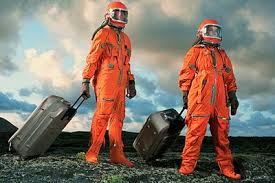 How close are we to sub-orbital flights being available to everyone?
How close are we to sub-orbital flights being available to everyone?
“To date, travel into space has been the purview of selected government, scientific and ultra-wealthy individuals. However, much activity is now taking place around the development of a sub-orbital space tourism market, with three operators actively soliciting passengers for their sub-orbital space tourism vehicles. It is predicted to become a USD 500 million revenue industry within 10 years.”
Currently, what are the risks involved?
“The market is in its infancy in terms of operators, regulation and the implications for passengers participating in this inherently risky activity. There is little data available on the physical risks that space flight participants will be exposed to during training and flight. In addition, the current US regulations for Reusable Launch Vehicles have been optimised to help operators develop the industry and limit their, and the US Government’s, liability. This potentially exposes the space flight participants to large and uncertain third-party liability risks.”
Who can afford space tourism?
“Current ticket prices for sub-orbital space tourism indicate that customers are likely to be high or ultra-high net worth individuals, who usually have extensive and sophisticated insurance cover in place, including for tax planning or business purposes. If the industry is to grow, it is vital that participants can enjoy a similar level of risk management and mitigation as is enjoyed in other adventure activities, leading to the eventual integration of space travel insurance cover in the same manner as the mature air travel industry.”
While ticket prices exclude the majority of us, is there a real market with existing competition?
“Two significant market studies have investigated the potential size of the sub-orbital space tourism market. The Futron Corporation published an updated report in 2006, which put the size of the market at more than USD 500 million in annual revenue after ten years. The Tauri Group 2012 estimated a lower amount of USD 50-150 million in 2012. As at July 2012, the combined total business disclosed across the sub-orbital space tourism operators is more than 900 reservations and about USD 80 million in deposits or fares. This indicates that the Futron estimates may be close to the initial size of the sub-orbital space tourism market. Although, this does not indicate a particularly large market, the Tauri study does identify potential future developments that could significantly increase the market size, namely rapid courier services and point-to-point passenger services. Target markets for sub-orbital space tourism operators will also include accompanied science experiments and training flights for possible deep space tourists and explorers.”
Who are the current players in the market?
“Virgin Galactic and XCOR Aerospace are two of the most mature operators in terms of test and deployment activity, keenly targeting the space tourism market with reusable launch vehicles.
“Virgin’s proposition involves spending about five minutes in free float microgravity during the flight, shared in a cabin with five other space flight participants and two crewmembers. The configuration of its system design, involving proven aircraft-like systems, a high-altitude rocket launch using non-volatile fuel and a low-temperature descent, seems to have a relatively high level of safety within the context of sub-orbital space tourism.
“XCOR’s Lynx vehicle is at an earlier stage of development and is intended to be a multipurpose vehicle for tourism but also for scientific and engineering flights. Four to six minutes of microgravity will be provided in a more compact cabin than Virgin’s, with just one space flight participant and one crewmember.
“Lynx’s configuration, involving quantities of volatile materials, a rocket-powered ascent from ground level and a high-heat re-entry profile implies a level of risk over and above both normal aircraft travel and, arguably, Virgin Galactic’s mission profile. However, Lynx’s target market is subtly different to Virgin’s – the former is appealing to the sort of person who might also purchase a flight in a jet fighter aircraft.
On the legal side, are sub-orbital space flight tickets comparable with purchasing a ticket on an aircraft?
“There is on-going debate about whether sub-orbital space tourism flights fall under space or aerospace law, and this landscape is likely to continue to evolve over a number of years. Part of the debate is about whether the sub-orbital space tourism operators’ aerospace vehicles are covered by air law, particularly whilst they are in space. Questions remain over how parts of this body of law, such as the Chicago Convention, its Annexes and regulations developed by the International Civil Aviation Organisation might be extended to apply to reusable launch vehicles. Current outer space law, as laid out in the five International Treaties, does not provide a comprehensive body of regulation for sub-orbital space tourism.”
So how would you characterise the current state of the market?
“In summary, the current sub-orbital space tourism market has a number of different competing systems, many vehicle concepts are untested and there is a lack of operational experience and data. Although the current regulatory framework has its drawbacks, moving from an experimental license to a complete type-certification regime would be likely to stifle the development and growth of the industry. However, the current framework can only be a temporary one on the way to a fully regulated industry.
“Questions remain over the feasibility of the informed consent or reciprocal waiver approach, and whether it would withstand a complete legal test. Also, as the industry develops towards a mass market, neither customers nor insurers will accept the current frontier approach to regulation and safety.”
If individuals should book space flights, what are the implication regarding their insurance?
“In general, an insurance applicant has a duty to disclose all material facts at the time of application for a policy. However, there is no duty to disclose if, for example, they are not considering sub-orbital space tourism at the time that the policy was underwritten.
“For life insurance, unless the policy has an unusual but not unique exclusion for non-commercial flight, a claim arising from a sub-orbital space tourism flight would be paid. Other covers such as critical illness or disability often have aviation exclusions, which are likely to be interpreted as applying to sub-orbital space tourism, notwithstanding some regulatory confusion between air law and space law for winged reusable launch vehicles. Finally, for non-life insurance such as travel, sub-orbital space tourism is certain to be treated as a hazardous activity due to the current licensing regime. Thus some parts of cover such as liability are likely to be excluded.
“A number of underwriters claim that they can offer space tourism insurance, including Torus Insurance and Atrium, a Lloyds syndicate. Aon ISB has also arranged personal accident cover for a number of orbital space tourists, covering accidental death, injury and disability. Cover was provided through a standard Lloyds policy for a sum insured of USD 1-2 million.
“Aon has made the interesting point that it may be in the best interests of an operator to provide personal accident insurance to space flight participants. As a quid pro quo, the space flight participant would then agree to waive the right to claim against the operator above this level of insurance. Aon also believes that, in the event of an incident, despite the presence of waivers between space flight participants and operators or governments, it would be difficult to prevent a claim for compensation being lodged with any of the responsible parties involved.”
Rob Frize is a Fellow of the Institute of Actuaries and a space industry consultant. For his executive MBA in space business and management at the International Space University in Strasbourg, France, his thesis covered sub-orbital human space flights and the associated risks and insurance issues.
Written by Torsten Kriening, who is a business development consultant with an executive MBA in space business and management from the International Space University in Strasbourg, France.












Add Comment